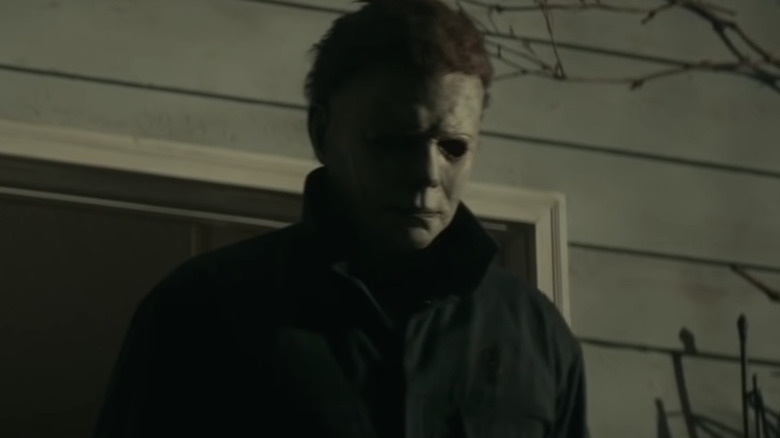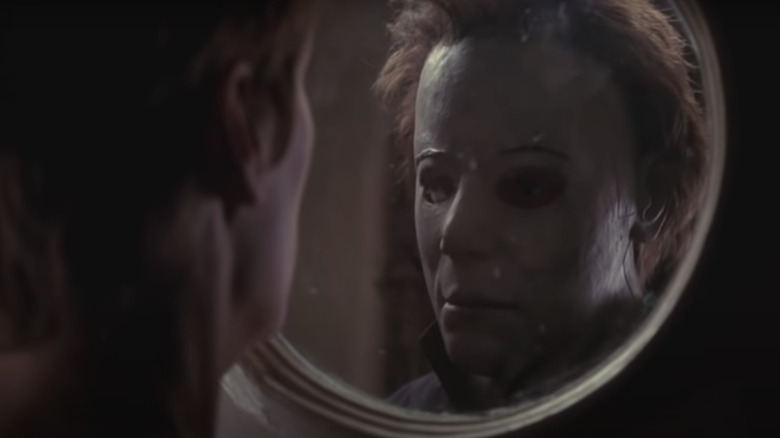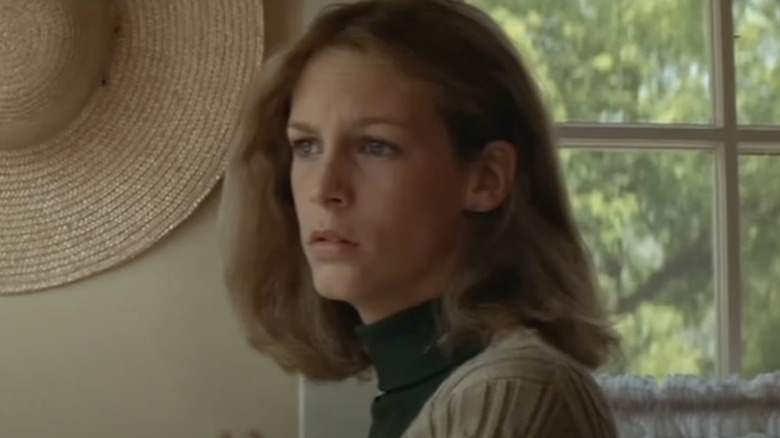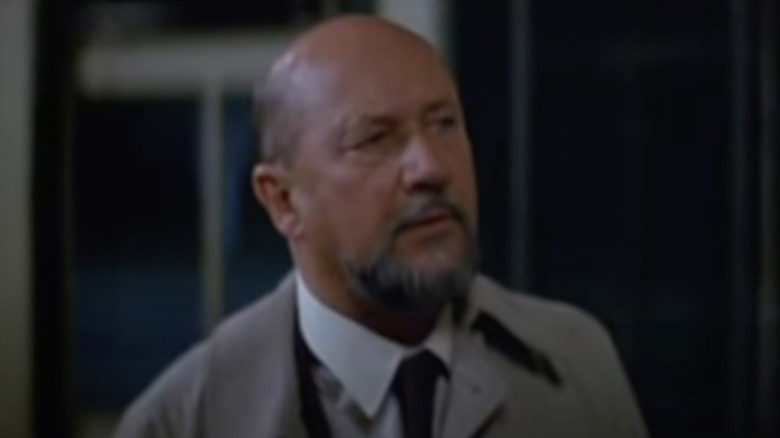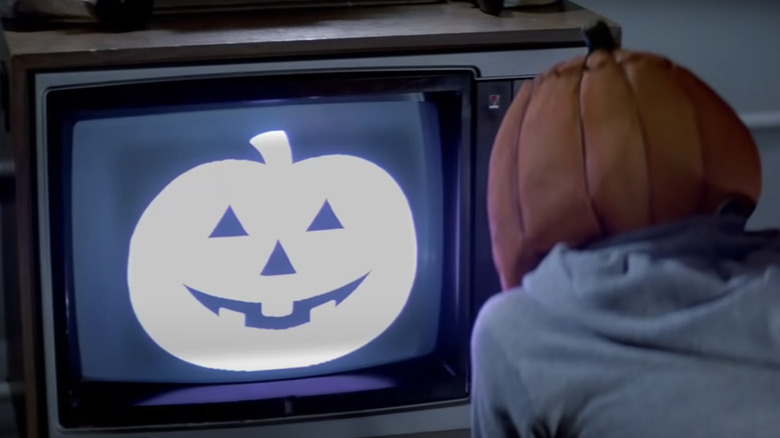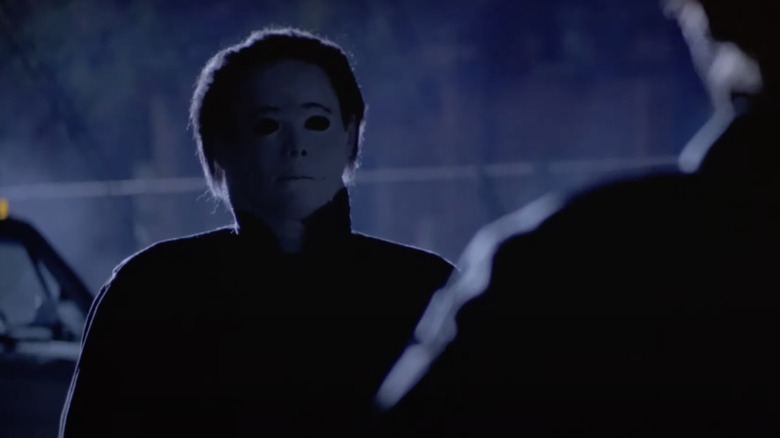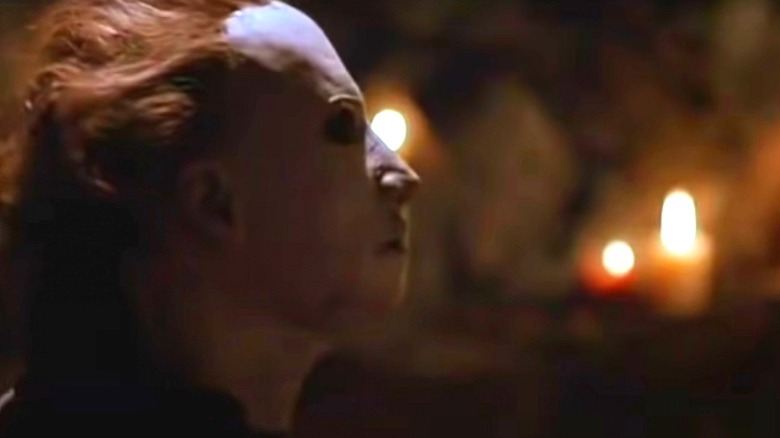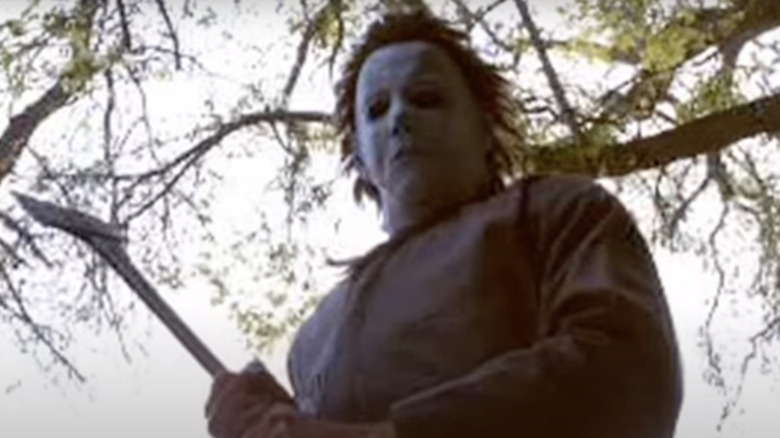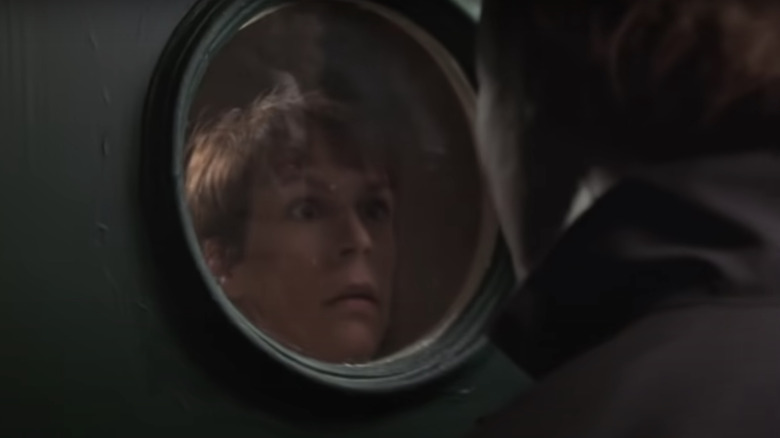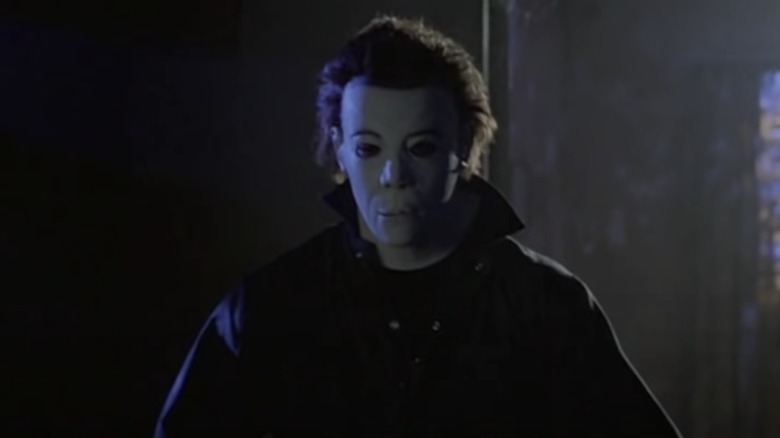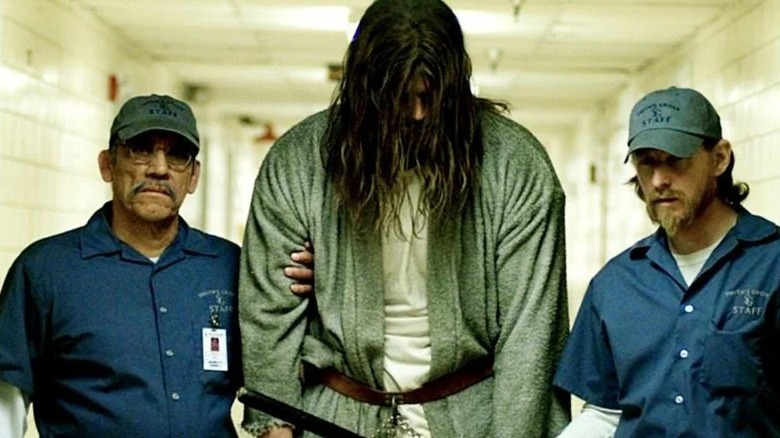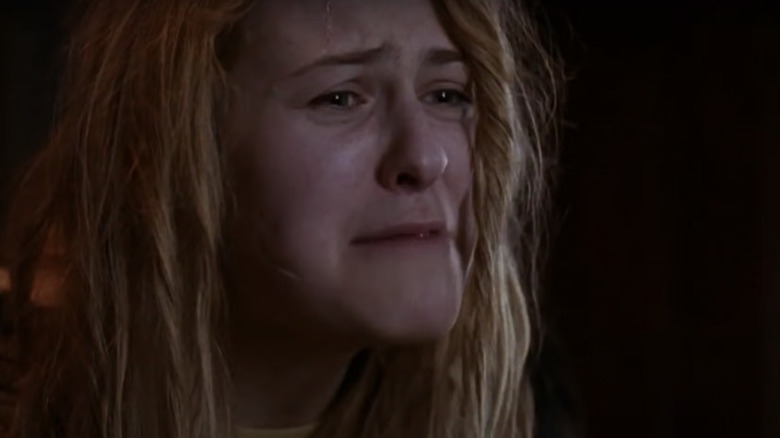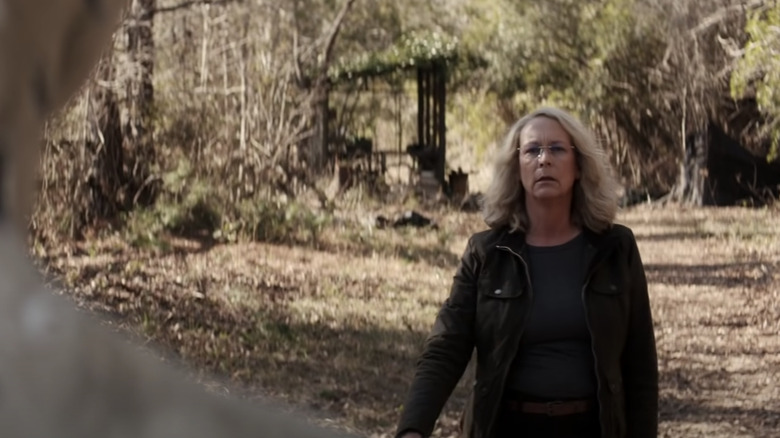This Is The Correct Order In Which To Watch The Halloween Movies
Spooktober is the most wonderful time of the year –– at least for Halloween aficionados, that is. Every year around October, fans of creepy season watch their favorite horror movies. It is, after all, a rite of passage. The all-time great slasher franchise, "Halloween," is on many people's lists. Yet the series consists not just of the movie that started it all, but the entire "Halloween" movie franchise. For those who are new to this slasher film franchise, you might be feeling a bit overwhelmed as there are 11 movies (and counting) in the series. Rest assured as we have you covered and will map out the correct order in which to watch them.
There are many ways, believe it or not, to view the films because there are four separate timelines. "Halloween" with all its retconning... And "Halloween 3" is a standalone film –– the story's events aren't related to the other movies, and everlasting slasher Michael Myers doesn't even make an appearance.
You could watch all the films in four separate timelines, yet that would mean you'd also have to watch "Halloween" (1978) three times. Bouncing around from movie to movie can have you questioning the special effects one moment and marveling at the newer movies the next, or vice versa, depending on how you like your horror movies served up. With "Halloween Kills" cutting into theaters in October 2021, there's only a limited amount of time left during the spooky season to prepare yourself for the Michael Myers madness.
Here is, dear macabre lovers, the correct order in which to watch the "Halloween" movies.
Enjoy the Halloween movies in each of its timelines –– if you dare
While we don't recommend watching the films like this, it's only right to mention all four timelines, as figuring out the sequence is a bloody roller-coast ride in itself.
If you want to watch the current timeline, then you'd watch these four movies in order: "Halloween" (1978), "Halloween" (2018), "Halloween Kills" (2021), and "Halloween Ends" (2022). At the time of this writing, "Kills" and "Ends" have yet to terrorize screens.
If you want to watch the original timeline, then you'd watch the movies in this order: "Halloween" (1978), "Halloween 2" (1981), "Halloween 4: The Return of Michael Myers," "Halloween 5: The Revenge of Michael Myers," and "Halloween: The Curse of Micheal Myers."
The second timeline consists of these movies: "Halloween" (1978), Halloween 2 (1981), "Halloween H20: 20 Years Later," and "Halloween: Resurrection."
Last but not least is the Rob Zombie reboot series, which includes "Halloween" (2007) and "Halloween II" (2009).
Again, there's also "Halloween 3: Season of the Witch," but the plot has nothing to do with the other movies, so you can watch it, really, whenever.
Start with Halloween (1978)
"Halloween" (1978) is the slasher film that started it all, so it only makes sense to watch this glorious film first. The movie stars the ultimate final girl Jamie Lee Curtis as Laurie Strode. The horror film features a mental patient, Michael Myers, who escapes his ward, goes on a killing spree, and then faces off against Laurie. We're still not sure if this is bad news for Laurie or Mr. Myers — likely a combination of both. Without giving too much away, Michael was committed because he killed his babysitting sister on Halloween night when he was just six years old. He escapes 15 years later and returns to his hometown of Haddonfield, Illinois. No one is safe, certainly not babysitters.
Although movies, especially horror films, tend to be dated by their special effects –– and, reminder, "Halloween" first cursed theaters in 1978 –– this film is still scary to this day, especially if you're watching it for the first time.
Halloween 2 (1981) is the natural first sequel
While there has been heavy debate over the years about the storyline and overall makeup of "Halloween 2" — case in point: it's since been retconned a handful of times — but it only makes sense to watch the original sequel after the inaugural movie. In this terror fest, Laurie and Michael pick up almost directly where the first story's events left off. This means, spoiler alert, that Donald Pleasence also reprises his respective role as Dr. Sam Loomis.
Believe it or not, this was supposed to be the final chapter of the Michael Myers and Laurie Strode saga. Carpenter and Hill originally didn't plan a third "Halloween," and only wanted to make one if it wasn't a direct continuation of the original story. As there have since been nine subsequent films and more to come, it's clear that the duo found something to keep the story going. If the "Halloween" franchise would have ended here, Michael Myers & Co. still would have been horror legends. Nevertheless, there's a plot twist that's, to say the least, to die for, and despite how "Halloween 2" ends, the show must and will go on.
Halloween 3: Season of the Witch (1982) provides a spooky intermission
"Halloween 3: Season of the Witch," for better or worse, has nothing to do with the original or retcon storylines. In fact, "Halloween 3" is a standalone film that can be watched at any point –– yet, why not watch it third, where it was meant to be watched? It's a good intermission (if you will), and despite the controversy surrounding the film's lack of Michael Myers, it's actually an entertaining story, especially if you like Halloween the holiday and lethal costumes.
Purists can rest easy knowing that this is the only film in the series that goes completely off the rails. Originally, the "Halloween" movies were supposed to be an anthology series with different Halloween-themed stories for each sequel. Yet, as history has told it, Michael Myers was –– and still is –– a hit. Naturally, the "Halloween" franchise reverted its attention back to a Michael-Myers-centered storyline after "Halloween 3."
Halloween 4: The Return of Michael Myers (1988) brings back the legend
After more than half a decade, Michael Myers, as the title of "Halloween 4" suggests, made his triumphant return. In this film, Michael wakes up from a 10-year coma and decides to focus his slasher intentions on targeting his niece, Jamie Lloyd (Danielle Harris). Luckily, Dr. Loomis also returns. Unfortunately, Laurie Strode doesn't make the reunion, yet her daughter, Jamie, is stuck in the nightmare, and the slasher horror legend is out to get her.
Despite this film not being as, let's say, good as the first two installments of the franchise, it still got the series back on track. Michael, against all odds, lives to fight another day and terrorize Haddonfield, Illinois in the process. Laurie, who actually survived the second movie, is unceremoniously killed off the screen. But if "Halloween" has taught fans anything, it's that the dead don't stay dead for long. This franchise has commonly gone on to totally rewrite history just to bring a fan favorite back from the grave.
Halloween 5: The Revenge of Michael Myers (1989) continues the current storyline
One year after Michael Myer's previous killing spree, he awakens from yet another coma and gets back to business. Once again, he's after his niece, Jamie Lloyd. Jamie, unfortunately, is institutionalized at a children's hospital due to the fourth chapter's unsettling events. She can no longer speak but somehow discovers a new ability, supernaturally linking her to Michael. Dr. Loomis returns for yet another go. They do their best to stop Michael, but the man, as is evident from a double-digit movie franchise, just can't ever seem to stay dead for long.
This film isn't necessarily a fan favorite (it has a 12 percent rating on Rotten Tomatoes), but the story must go on. The film was released only one year after "Halloween 4," and it shows in the plot. Nevertheless, plenty of Michael Myers adventures will continue, despite a six-year hiatus between the fifth and sixth chapters of the franchise.
Halloween: The Curse of Michael Myers (1995) adds a wicked cult layer
Unfortunately, "Halloween: The Curse of Michael Myers" was even less critically acclaimed than "Halloween 5," as it earned a Rotten Tomatoes score of 9 percent. However, Dr. Loomis returns yet again, and Paul Rudd even makes an appearance as Tommy Doyle, a boy Laurie Strode babysat. Things get really weird in "The Curse of Michael Myers." A cult aspect, for example, tries to explain Michael Myers' terror.
Although it's not the next film released in the series, the Producer's Cut of "Halloween: The Curse Of Michael Myers" was released in 2014, and it rewrote the ending of the version that came out in 1995. Audience members don't necessarily have to watch the 2014 film, as it is, after all, a producer's cut and came more than a decade after the 1995 version. At that point, the damage had already been done. "The Curse of Michael Myers" didn't quite reach the quality of the first two movies, but that didn't stop more films from being released.
Halloween H20: 20 Years Later (1998) is the first franchise reset
"Halloween H20: 20 Years Later (1998)," as its name suggests, takes place 20 years after the first film. Similar to the first film, Jamie Lee Curtis is back as Laurie Strode. Resetting the timeline, "Halloween H20" follows the events of "Halloween 2" (1981).
But how exactly is Laurie back? Simple: she faked her death in a car accident that originally killed her off the screen. With this decision, the "Halloween" franchise effectively received its first –– yet not last –– retcon, overwriting all the madness that happened in the previous films that came after "Halloween 2." But don't be too alarmed. Michael Myers returns and he is, naturally, after Laurie. Actors Michelle Williams and Josh Hartnett also join the mix, as do LL Cool J and Joseph Gordon-Levitt. Although not perfect, "Halloween H20" got the franchise back on track. Well, at least for one more movie in this new timeline, that is.
Halloween: Resurrection (2002) ends the reset storyline
"Halloween: Resurrection" (2002) sees a group of contestant winners re-enter the insanity: Internet reality show "Dangertainment," directed by Freddie Harris (Busta Rhymes) and Nora Winston (Tyra Banks), has these contestants spending a night in Michael Myer's abandoned childhood house to figure out his demented mind and endless rampage. Oh yeah, and obviously Michael crashes the party and goes on another one of those darn killing sprees.
Jamie Lee Curtis briefly returns, and then the rest of the movie kind of blows up in flames. Yet, the movie was successful enough to spawn another film five years later, though the said film rewrites history yet again. "Halloween: Resurrection" seemingly ended Michael's reign, until, spoiler alert, he comes back to life just as the movie ends. The man just won't die. "Halloween: Resurrection" ostensibly ends this storyline. but nothing can keep Michael from coming back to life, not even the story being totally rewritten.
Halloween (2007) restarts the franchise from the beginning
Rob Zombie took over the creative reins in "Halloween" (2007), a film that rebooted the series from scratch. The film is a remake of the first installment, not that it necessarily needed one. Though it's not as highly regarded as the first movie in the franchise –– it never really stood a chance since the first film is a horror classic –– Zombie does add some unique elements to the (killing) table. Most notably, his version of "Halloween" is violent and brutal.
Of course, Michael Myers is back, as is Laurie Strode and Dr. Sam Loomis, though new actors were brought into the mix. The film revolves around Michael's history and development, why he is the way he is, all before he returns to Haddonfield and goes on yet another killing spree. Though the film follows in the original movie's footsteps when it comes to plot points and story, it's a violent rehash (did you expect anything less from Rob Zombie?) of the inaugural film, and it didn't work for all fans of the franchise.
Halloween 2 (2009) is Rob Zombie's sequel
Rob Zombie's first "Halloween" was good enough to spawn a sequel. Enter "Halloween 2" (2009), yet another remake. Laurie Strode, Dr. Loomis, and Michael Myers have yet another "final" showdown. This reboot, however, shocked viewers with a twist, going off the tracks from the original movie's first sequel. This should have been expected, as Zombie had his own vision for the franchise.
The franchise could have certainly stopped here if it wanted to, or even continued this particular story, but why rain on the parade when yet ANOTHER remake could, well, be remade. Nevertheless, Zombie's take on this horror classic is violent, disturbing, and everything else you'd expect from the man who started the sinister Firefly family trilogy with the cult classic "House of 1000 Corpses." This two-film "Halloween" reboot has Zombie's style splattered all over it. If you're a fan of his movies, then this is a welcome surprise.
Halloween (2018) retcons everything after the 1978 original
Against all odds, Jamie Lee Curtis returns as Laurie Strode, but how can that be? The creators of "Halloween" decided to end Zombie's run, gift the camera to David Gordon Green, and totally rewrite (once again) part of the franchise's history.
"Halloween" (2018) ignores all sequels in the canon and places Laurie four decades into the future while leaving Michael Myers in custody since the events of the first movie in 1978. The bloodbath that inevitably ensues breathes new life into the franchise. Though it can be irritating to see a franchise being rewritten time after time, this retcon was met with high praise to the tune of a 79 percent rating on Rotten Tomatoes and a monster showing at the box office. Naturally, especially for this horror series, it would only make sense for more sequels. As this movie started off the new timeline, it only seems right to watch this before checking out "Halloween Kills" (2021) and "Halloween Ends" (2022).
There are many ways to watch this complicated slasher franchise, yet watching them in the order that they were released is probably the most straightforward and least time-consuming.
